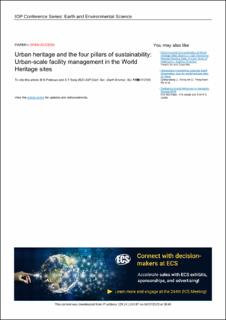| dc.contributor.author | Prabowo, Bintang Noor | |
| dc.contributor.author | Temeljotov Salaj, Alenka | |
| dc.date.accessioned | 2023-09-11T06:28:20Z | |
| dc.date.available | 2023-09-11T06:28:20Z | |
| dc.date.created | 2023-08-25T22:02:21Z | |
| dc.date.issued | 2023 | |
| dc.identifier.citation | IOP Conference Series: Earth and Environmental Science (EES). 2023, 1196 . | en_US |
| dc.identifier.issn | 1755-1307 | |
| dc.identifier.uri | https://hdl.handle.net/11250/3088517 | |
| dc.description.abstract | The discussion addressing sustainability issues of the World Heritage (WH) as cultural sites that hold outstanding universal values (OUV) has started to surface since the adoption of the “Strategic Action Plan for the Implementation of the World Heritage Convention 2012-2022”, specifically in the third goal, which states that “heritage protection and conservation should consider present and future environmental, societal, and economic needs.” This goal aligned with the first three pillars of sustainability. After the introduction of “culture” as the fourth pillar of sustainability by UCLG in 2011, the issue of sustainability in the WH sites has drawn global attention. The balance of all four pillars of sustainability within protected sites can potentially be achieved by improving efficiencies through urban-scale facility management (Urban FM). The principles of Urban FM aligned with UNESCO’s recommendation on the Historic Urban Landscape (HUL) approach, which is a holistic approach to managing historic sites. This study discusses aspects of managing urban-scale facilities in urban heritage areas and aims to shed light on the knowledge of Urban FM at WH sites by employing a literature review approach. The preliminary findings indicate that culture, the fourth pillar of sustainability, was involved and bound to the other three pillars: economic, social, and environmental. Within WH sites, urban-scale facility management needs to be considered seriously to ensure the protection of OUV that efficiently defines the existence of their status as World Heritage. | en_US |
| dc.description.abstract | Urban heritage and the four pillars of sustainability: Urban-scale facility management in the World Heritage sites | en_US |
| dc.language.iso | eng | en_US |
| dc.publisher | IOP Publishing | en_US |
| dc.rights | Navngivelse 4.0 Internasjonal | * |
| dc.rights.uri | http://creativecommons.org/licenses/by/4.0/deed.no | * |
| dc.title | Urban heritage and the four pillars of sustainability: Urban-scale facility management in the World Heritage sites | en_US |
| dc.title.alternative | Urban heritage and the four pillars of sustainability: Urban-scale facility management in the World Heritage sites | en_US |
| dc.type | Peer reviewed | en_US |
| dc.type | Journal article | en_US |
| dc.description.version | publishedVersion | en_US |
| dc.source.pagenumber | 8 | en_US |
| dc.source.volume | 1196 | en_US |
| dc.source.journal | IOP Conference Series: Earth and Environmental Science (EES) | en_US |
| dc.identifier.doi | 10.1088/1755-1315/1196/1/012105 | |
| dc.identifier.cristin | 2169843 | |
| cristin.ispublished | true | |
| cristin.fulltext | original | |
| cristin.qualitycode | 1 | |

